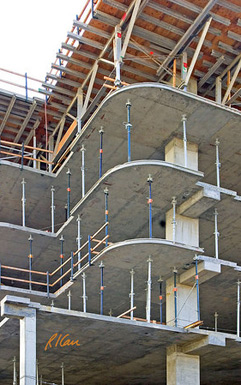Bay Area Concrete Aggregates |
|||
|
Aggregate Basics
Aggregates generally make up about 75% of the volume in a yard of concrete. Of that 75%, approximately 60% is the coarse aggregate. The art and science of concrete mix design uses refinements in proportions, gradations, and aggregate surface characteristics to produce concrete with specific workability, finishability and, pumpability. As engineers however, we are primarily interested in properties of the hardened concrete such as strength, durability, and resistance to shrinkage and cracking. Coarse aggregates are either gravels (dug or dredged, then washed and graded) or crushed stones (produced by crushing quarry rocks or large gravels). The base material consists of a mixture of rocks and minerals. Minerals, like quartz, feldspar and gypsum, have an orderly internal structure and a narrowly defined chemical composition. Rocks, like granite, limestone and chert, are generally composed of several minerals. Important engineering properties include hardness, durability, strength, and freedom from materials or chemicals that could affect hydration or bond with the cement paste. Since aggregates are typically quite strong (10 to 40 KSI compressive strength) compared to the cement paste, for concrete strengths up to 6000 psi or so, actual compressive strength of the aggregate does not have a large influence on concrete compressive strength. Aggregate properties that can affect concrete quality are discussed below: Gradation: The specific blend of particle sizes within an aggregate can affect workability, strength, density, shrinkage characteristics and cost of the concrete. Soundness: Aggregates that are highly absorptive, porous, or prone to volume changes when saturated will produce unstable, weak concrete with poor durability. Cleanness: Impurities in the aggregate, such as clays, silt, or organic material, will result in concrete with reduced durability, low strength, potential for excess shrinkage and unsatisfactory appearance. Hardness: Aggregates with insufficient hardness and toughness will produce concrete with poor abrasion resistance and may not be appropriate for higher strength concrete. Particle Shape: Angular aggregates, generally produced by crushing, can result in greater flexural strength compared to concrete made with rounded aggregates, but the mix becomes harsher, affecting workabililty and the ability of the concrete to fully encase congested reinforcement. Reactivity: The alkali-silica reaction is the most common form of aggregate reactivity. Concrete made with such aggregate is damaged by the expansion of the cement paste around the aggregate. Substantial cracking along with general deterioration of the concrete results.
|
 Home
Home
|
||
